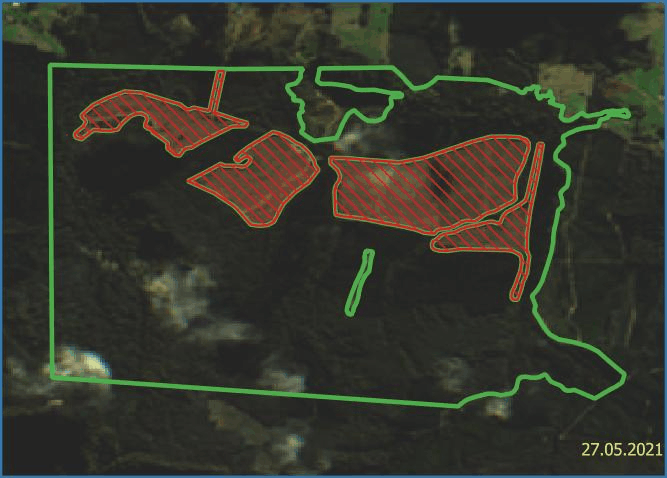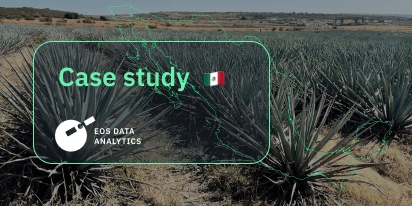
EOSDA Technologies Help Meet Modern Forestry Challenges
Overall, global demand for wood products is expected to quadruple by 2050. What are the current trends and challenges in the market and how to meet them? The case study will provide you with the answers.
In June 2020, a Tasmanian forestry management company, Forico, adopted the automated harvest progress reporting on a monthly basis offered by EOSDA Forest Monitoring (now part of EOSDA custom forestry solutions). How did the company come to this decision and what results have already been achieved? Find out in this case study.
Overview: About Forico
Forico is the leading private forestry management company in Tasmania, laser-focused on preserving the natural environment. Established in 2014, the company now manages over 173,000 ha of land. In its pursuit of sustainable usage of natural resources, Forico relies on knowledge and innovation.
All harvesting occurs on plantation forest, and is scheduled based on age-class, but also spread over time and space in areas such as the Tasmanian Devil habitat to ensure availability of a variety of age-classes in their habitat range. Harvesting plans are prepared in accordance with the Forest Practices Code for Tasmania and include stream protection, soil erosion mitigation, and landscape habitat design for Wedge-tailed Eagles. Across the estate we harvest up to 5,000 ha per annum depending on the wood flow schedule to achieve sustainable levels in the long-term planning horizon.
Problem: Growing Demand For Sustainable Forest Farming
Although the COVID-19 pandemic has affected the export of Forico’s products and the timber market in general, it is only a short-term problem. There are, of course, other factors, such as the continuously evolving proposition from competitors and economic fluctuations, but, overall, the demand for wood products is expected to grow in the following decades.
Sustainability is an essential aspect of doing business nowadays. The market landscape is shifting towards a demand for 100% plantation-sourced wood supply. Environmental concerns lead to opting for short-rotation plantation wood and recycled waste material, while the clients want to rely on certified growers like Forico.
Solution: Harvest Progress Reporting
To meet the new challenges, companies like Forico must make innovation an essential part of their production process.
To enhance planning and recording of harvest, the company started using machine learning. And to drive the efficiency of harvest monitoring even further, Forico adopted a monthly automated harvest progress reporting offered by EOSDA Forest Monitoring, a satellite-based software for forestry management.
The immediate benefit of automated reports for Forico is the higher accuracy of data collected over a short amount of time. This ensures higher standards of production and better quality of products.
When it comes to sustainable forestry practices, Forico’s primary objectives are as follows:
- Protecting and enhancing natural forest values
- Optimizing weed control
- Restoring riparian zones from plantation species to native species
- Planning rehabilitation and revegetation at a landscape level
- Implementing holistic solutions for a catchment
- Managing the interface between grasslands, heathlands and rainforests
- Managing forest fire risks
- Preserving intact ecosystems (e.g. Ptunarra butterfly)
It’s important to mention that Forico performs logging (a.k.a. wood harvesting) only on plantation territories where trees are bred specifically for this purpose. Therefore, the native forest is preserved. In this regard, EOSDA Forest Monitoring also becomes a handy platform for managing harvesting activities. The latter need to be scheduled based on the age and class distribution. So, instead of dealing with such specific tasks in general-purpose online maps, now Forico has a handy digital tool that is crafted specifically to meet the needs of their professional crews while achieving business goals.
Forico specialists found that automated EOS Data Analytics reporting saves time and increases accuracy of the data obtained. This adds value to the business by having accurate records for harvest monitoring and forward scheduling of crews. They are also able to receive information on cloudy days which occur a lot in the winter months. Previously, Forico just relied on data from field crews to manually estimate harvest progress, which was less reliable because they didn’t have a good appreciation of the context of the whole harvesting block. Therefore, decision-makers tended to over or underestimate quite easily. With the Earth observation satellites, they can now assess progress more precisely.
In addition, Forico is using EOSDA Forest Monitoring to transform its breeding program from traditional breeding trials, selection and cultivation methods to a technologically advanced molecular breeding program. By doing that, they have established themselves as one of the first forestry companies in the world to deploy such an advanced technology at an industrial scale. In particular, the company has implemented its unique tree-breeding program for three species:
- Eucalyptus globulus,
- Eucalyptus nitens,
- Pinus radiata.
Using the marker-aided selection method, growers pick superior trees to enhance the quality of the end product.
Outcome: Saved Time And Increased Accuracy
The transition from manual field crew gathering of data to digital transformation by means of EOSDA Forest Monitoring has optimized Forico’s operations and enabled it to implement precision forestry practices. Insights based on data acquisition and analytics from satellite imagery allow the company to manage and assess the progress of harvesting both effortlessly and reliably. Using cloud-free satellite images provided by EOSDA Forest Monitoring, Forico is able to generate detailed reports of the harvest progress even on cloudy days.
We found that automated EOS Data Analytics reporting saves time and increases accuracy. This adds value to the business by having accurate records for harvest monitoring and forward scheduling of crews. We are also able to obtain information on cloudy days which occur a lot in the winter months.

Armed with all these innovative management techniques, Forico maintains its leading position on Tasmania’s forestry market.
By implementing remote sensing analytics, Forico has demonstrated an innovative forward-thinking approach to land management. They’ve capitalized on their diverse land estate, strategically transforming underperforming areas by planting the most suitable species for each location after thorough analysis of available multispectral data. This tactic not only boosts the forest’s biological health but also acts as a formidable risk-mitigation tool for the company’s future, especially concerning market fluctuations and biosecurity. Thanks to their consistent investments in genetic enhancement, precision nutrition, and now precision silviculture, Forico’s plantations are witnessing year-on-year improvement, setting new benchmarks in sustainable forestry practices.
About the author:
Rim Elijah holds a double degree in business administration and political science from Stockholm University. As a VP of Sales at EOSDA, she oversees all aspects of business model development and implementation and the growth of the company’s global coverage. She has successfully established a number of strategic partnerships with an emphasis on sustainable solutions in Africa and Asia.
Recent articles

Digital Tools Improve Soil Health And Yields In Mexico
EOSDA and ITTA supported a Guanajuato farm with contour-line planning, monitoring tools, and practical guidance to reduce soil erosion and improve yields in the long run.

Analyze 2025 & Plan Your Best Year Yet: LandViewer Christmas Offer
It’s the most wonderful time of the year! The Christmas holidays are here, and so is your chance to analyze 2025 and plan a prosperous 2026 with more affordable Pro plans in LandViewer.

EOSDA Models Climate Change Impact On Sugarcane Yields
EOSDA modeled future temperature, rainfall, and other climate impacts on Veracruz sugarcane. The results help growers plan long-term adaptation strategies, including timing, varieties, and irrigation.